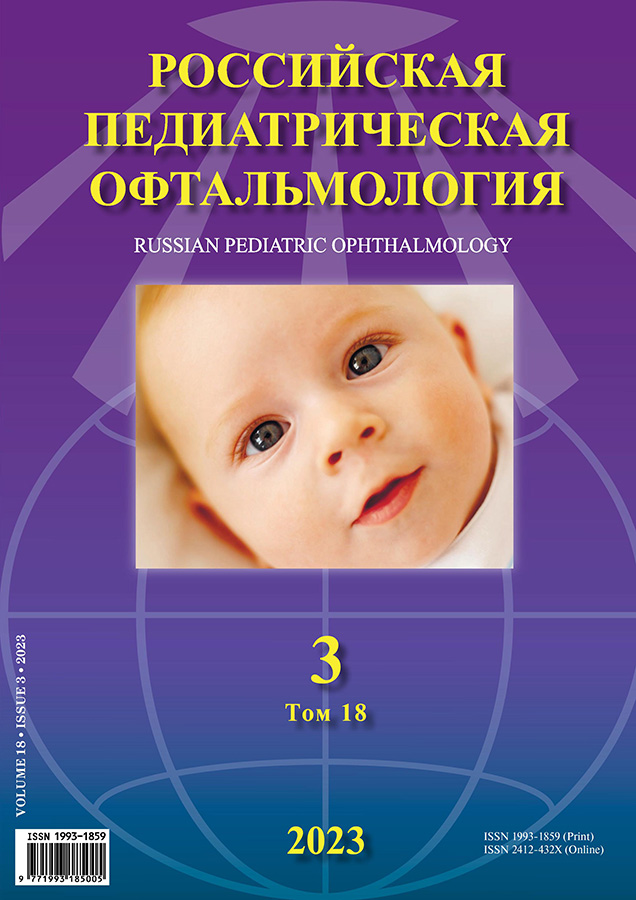Scleritis in children: Etiology, pathogenesis, clinical features, diagnostic, and treatment algorithm
- Authors: Kovaleva L.A.1, Baisangurova A.A.1, Kuznetsova T.V.1, Zaitseva A.A.1
-
Affiliations:
- Helmholtz National Medical Research Center of Eye Diseases
- Issue: Vol 18, No 3 (2023)
- Pages: 119-127
- Section: Original study article
- URL: https://bakhtiniada.ru/1993-1859/article/view/163777
- DOI: https://doi.org/10.17816/rpoj567972
- ID: 163777
Cite item
Abstract
AIM: To analyze the etiology and pathogenesis and identify clinical and diagnostic features, development of a diagnostic algorithm, and personalized treatment of scleritis in children.
MATERIALS AND METHODS: Twelve children with mono- and bilateral scleritis with disease duration of 3–9 months were observed. Biomicroscopy, ophthalmoscopy, and ultrasonography of the eyes were performed. The examination plan included consultations with a rheumatologist, otorhinolaryngologist, and dentist and laboratory blood analysis in the enzyme immunoassay to detect the presence of IgG and IgM antibodies to herpes viruses and markers of their reactivation.
RESULTS: Chronic scleritis in 58.4% of the patients was associated with immunoinflammatory rheumatic diseases: 41.7% with juvenile idiopathic arthritis and 16.7% with psoriatic arthritis. In some cases scleritis was associated with chickenpox, surgical treatment of congenital pigmented nevus of the skin of eyelids,n on the conjunctiva and oculomotor muscles, otogenic neuritis of the facial nerve. Сlinical features of anterior deep scleritis and symptoms of bacterial scleritis are described. Personalized schemes for the diagnosis and treatment of scleritis in children have been developed. Conservative treatment included instillation of glucocorticoids and non-steroidal anti-inflammatory drugs. In addition, to anti-inflammatory therapy, antibacterial drugs are prescribed only in the presence of clinical signs of bacterial scleritis; in other cases, their use is inappropriate. The indications for antiviral therapy included laboratory confirmation of herpes infection reactivation. Personalized etiotropic therapy made it possible to achieve remission of scleritis in 9–14 days.
CONCLUSION: This study analyzed the etiopathogenesis of scleritis, described the characteristic clinical features of anterior deep scleritis in children, and developed personalized diagnostic and treatment schemes.
Full Text
##article.viewOnOriginalSite##About the authors
Ludmila A. Kovaleva
Helmholtz National Medical Research Center of Eye Diseases
Author for correspondence.
Email: ulcer.64@mail.ru
ORCID iD: 0000-0001-6239-9553
SPIN-code: 1406-5609
Scopus Author ID: 682934
MD, Cand. Sci. (Med.)
Russian Federation, MoscowAlbina A. Baisangurova
Helmholtz National Medical Research Center of Eye Diseases
Email: alia-bai-5@mail.ru
ORCID iD: 0000-0002-8014-667X
SPIN-code: 2308-0920
MD, Ophthalmologist
Russian Federation, MoscowTatjana V. Kuznetsova
Helmholtz National Medical Research Center of Eye Diseases
Email: tatakuzn@gmail.com
ORCID iD: 0009-0005-1333-2420
SPIN-code: 4815-6968
MD, Ophthalmologist
Russian Federation, MoscowAlina A. Zaitseva
Helmholtz National Medical Research Center of Eye Diseases
Email: alisha_klin@mail.ru
ORCID iD: 0000-0001-8852-3305
SPIN-code: 8965-1586
MD, Ophthalmologist
Russian Federation, MoscowReferences
- Akpek EK, Thorne JE, Qazi FA, et al. Evaluation of patients with scleritis for systemic disease. Ophthalmology. 2004;111(3):501–506. doi: 10.1016/j.ophtha.2003.06.006
- Okhravi N, Odufuwa B, McCluskey P, Lightman S. Scleritis. Surv Ophthalmol. 2005;50(4):351–363. doi: 10.1016/j.survophthal.2005.04.001
- Sainz de la Maza M, Molina N, Gonzalez-Gonzalez LA, et al. Clinical characteristics of a large cohort of patients with scleritis and episcleritis. Ophthalmology. 2012;119(1):43–50. doi: 10.1016/j.ophtha.2011.07.013
- Homayounfar G, Nardone N, Borkar DS, et al. Incidence of scleritis and episcleritis: results from the Pacific Ocular Inflammation Study. Am J Ophthalmol. 2013;156(4):752–758. doi: 10.1016/j.ajo.2013.05.026
- Watson PG, Hayreh SS. Scleritis and episcleritis. Br J Ophthalmol. 1976;60(3):163–191. doi: 10.1136/bjo.60.3.163-191
- Wieringa WG, Wieringa JE, ten Dam-van Loon NH, Los LI. Visual outcome, treatment results, and prognostic factors in patients with scleritis. Ophthalmology. 2013;120(2):379–386. doi: 10.1016/j.ophtha.2012.08.005
- Akintayo RO, Adelowo OO, Egajifo O, et al. The impact of ocular manifestations of rheumatoid arthritis on the health-related quality of life and the functional ability of black Africans. Int Ophthalmol. 2019;39(5):1003–1012. doi: 10.1007/s10792-018-0902-6
- Sharma SM, Damato E, Hinchcliffe AE, et al. Long-term efficacy and tolerability of TNFα inhibitors in the treatment of non-infectious ocular inflammation: an 8-year prospective surveillance study. Br J Ophthalmol. 2019;105(9):1256–1262. doi: 10.1136/bjophthalmol-2018-312767
- Sainz de la Maza M, Molina N, Gonzalez-Gonzalez LA, et al. Scleritis therapy. Ophthalmology. 2012;119(1):51–58. doi: 10.1016/j.ophtha.2011.07.043
- Héron E, Bourcier T. Scleritis and episcleritis. J Fr Ophtalmol. 2017;40(8):681–695. (In French). doi: 10.1016/j.jfo.2017.04.007
- Gonzalez-Gonzalez LA, Molina-Prat N, Doctor P, et al. Clinical features and presentation of infectious scleritis from herpes viruses: a report of 35 cases. Ophthalmology. 2012;119(7):1460–1464. doi: 10.1016/j.ophtha.2012.01.033
- Kovaleva LA, Krichevskaya GI, Davydova GA, Zaitseva AA. Сhronic unilateral anterior nodular scleritis with local inflammation of the ciliary body associated with the varicella-zoster virus. Russian Pediatric Ophthalmology. 2022;17(2):31–38. (In Russ). doi: 10.17816/rpoj105641
- Pavesio CС, Meier FM. Systemic disorders associated with episcleritis and scleritis. Curr Opin Ophthalmol. 2001;12(6):471–478. doi: 10.1097/00055735-200112000-00013
- Erhardt CC, Mumford PA, Venables PJ, Maini RN. Factors predicting a poor life prognosis in rheumatoid arthritis: an eight year prospective study. Ann Rheum Dis. 1989;48(1):7–13. doi: 10.1136/ard.48.1.7
- Foster CS, Forstot SL, Wilson LA. Mortality rate in rheumatoid arthritis patients developing necrotizing scleritis or peripheral ulcerative keratitis: effects of systemic immunosuppression. Ophthalmology. 1984;91(10):1253–1263. doi: 10.1016/s0161-6420(84)34160-4
- Braithwaite T, Subramanian A, Petzold A, et al. Trends in Optic Neuritis Incidence and Prevalence in the UK and Association With Systemic and Neurologic Disease. JAMA Neurol. 2020;77(12):1514–1523. doi: 10.1001/jamaneurol.2020.3502
- Abd El Latif E, Seleet MM, El Hennawi H, et al. Pattern of Scleritis in an Egyptian Cohort. Ocul Immunol Inflamm. 2019;27(6):890–896. doi: 10.1080/09273948.2018
- Ando Y, Keino H, Nakayama M, et al. Clinical Features, Treatment, and Visual Outcomes of Japanese Patients with Posterior Scleritis. Ocul Immunol Inflamm. 2020;28(2):209–216. doi: 10.1080/09273948.2019
- Lane J, Nyugen E, Morrison J, et al. Clinical Features of Scleritis Across the Asia-Pacific Region. Ocul Immunol Inflamm. 2019;27(6):920–926. doi: 10.1080/09273948.2018.1484496
Supplementary files










